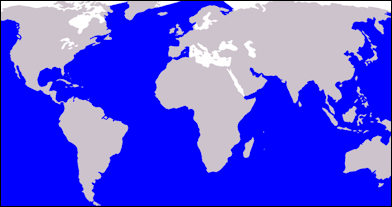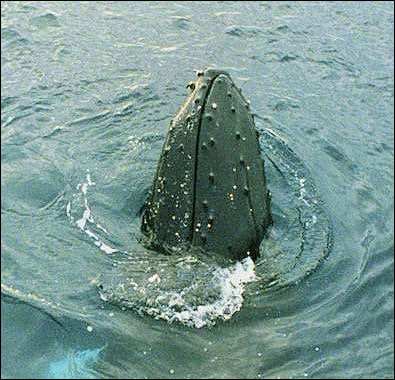Home | Category: Baleen Whales (Blue, Humpback and Right Whales)
HUMPBACK WHALES
Humpback whales (Scientific name: Megaptera novaeangliae) are famous for their songs and commonly seen on whale-watching trips. Members of the roqual family of baleen whales, they are found in most of the world's oceans. Herman Melville described them as "the most gamesome and light-hearted of all the whales." The 1971 album “ Songs of the Humpback Whale” was a big hit. Humpback songs were even sent into deep space on the Voyager space craft. [Source: Douglas H. Chadwick, National Geographic, January 2007 and July 1999; Virginia Morell, Smithsonian magazine, February 2008]
Humpbacks whales are the 5th largest animal in the world. They get their name from the hump on the forward part of the dorsal fin and they way they arch their backs before they dive. Their scientific name “Megaptera novaeangliae” (“giant wing of New England”) is reference to its long pectoral fins, or flippers, and the fact the ones were first described scientifically were in waters off the northeast United States. Humpback whales probably live about 80 to 90 years.
Humpback whales travel incredible distances every year and have one of the longest migrations of any mammal on the planet. Some populations swim 8,000 kilometers (5,000 miles) from tropical breeding grounds to colder, plentiful feeding grounds. Humpback whales feed on shrimp-like krill and small fish, straining huge volumes of ocean water through their baleen plates that act like a sieve. Humpbacks are popular with whale watchers because they are often active at the surface, jumping out of the water and slapping the surface with their pectoral fins or tails. [Source: NOAA]
Related Articles: CATEGORY: BALEEN WHALES (BLUE, HUMPBACK AND RIGHT WHALES) ioa.factsanddetails.com ; Articles: HUMPBACK WHALES FEEDING ioa.factsanddetails.com; HUMPBACK WHALE REPRODUCTION, MATING, PARENTING AND YOUNG ioa.factsanddetails.com ; HUMPBACK WHALE BEHAVIOR, DISPLAYS AND MIGRATIONS ioa.factsanddetails.com ; HUMPBACK WHALE SONGS: STRUCTURE, CHANGES, SINGING AND WHY THEY ARE SUNG ioa.factsanddetails.com ; ENDANGERED HUMPBACK WHALES, HUMANS, SHARKS AND ORCAS ioa.factsanddetails.com ; WHALES: CHARACTERISTICS, ANATOMY, BLOWHOLES, SIZE ioa.factsanddetails.com ; HISTORY OF WHALES: ORIGIN, EVOLUTION, SPECIES ioa.factsanddetails.com ; WHALE BEHAVIOR, FEEDING, MATING ioa.factsanddetails.com ; WHALE COMMUNICATION AND SENSES ioa.factsanddetails.com ; WHALING: HISTORY, TECHNIQUES ioa.factsanddetails.com ; ENDANGERED WHALES AND HUMANS ioa.factsanddetails.com
Websites and Resources: Humpback organizations and experts: the Maui-based Whale Trust; Lou Herman of the Honolulu-based Dolphin Institute has published more than hundred papers on humpbacks, their songs, their migration patterns, and interaction between mothers and calves. Animal Diversity Web (ADW) animaldiversity.org; National Oceanic and Atmospheric Administration (NOAA) noaa.gov; Fishbase fishbase.se; Encyclopedia of Life eol.org; Smithsonian Oceans Portal ocean.si.edu/ocean-life-ecosystems ; Monterey Bay Aquarium montereybayaquarium.org ; MarineBio marinebio.org/oceans/creatures
Humpback Whale Habitats and Where They Are Found

Humpback range Humpback whales live throughout the world's major oceans, mainly the the Arctic Ocean, Atlantic Ocean and Pacific Ocean. They can be found in polar and tropical waters. Their range includes waters in the Bering Sea and around Antarctica. [Source: Mindy B. Kurlansky, Animal Diversity Web (ADW) /=]
Humpback whales travel great distances during their seasonal migration with some animals migrating 8.000 kilometers (5,000 miles) between high-latitude summer feeding grounds and winter mating and calving areas in tropical waters. In the North Pacific, some humpback whales migrate from Alaska to Hawaii — they can complete the 4,900 kilometer (3,000 mile) trip in as few as 36 days. While calving, they prefer shallow, warm waters commonly near offshore reef systems or shores. Humpback whale feeding grounds are generally in cold, productive waters. [Source: NOAA]
The habit of humpbacks to gather around islands and shorelines in tropical breeding areas and polar feeding areas made them easy prey for whalers. During migration, humpack whales are found in coastal and deep oceanic waters. Generally, they do not come into coastal waters in the western Atlantic Ocean until they reach latitudes the same as those of Long Island, New York, and Cape Cod, Massachessetts. /=\
Humpback Whale Populations
Humpbacks range over a large area and are difficult to count. There are perhaps 70,000 of them worldwide, down from around 250,000 to 300,000 in the early 1900s but up from maybe as few as 7,000 in the 1960s. Based on whaling records, scientists estimated that whaling nations (primarily the United States, Britain, Norway and Australia) killed more than 250,000 humpbacks in the 20th century. Humpback numbers are now deemed healthy. In 2008 the International Union for Conservation of Nature said it was moving the whales from the list of species vulnerable to extinction to the list of ones with a low risk of extinction. At one times humpbacks were considered seriously endangered. Their comeback has been credited to the ban on whale hunting.

Humpback in Antarctica Humpbacks are divided into several populations. In 2016, The National Marine Fisheries Service said it had evidence that here were 14 distinct populations of humpback whales around the world, and of these nine had recovered to the point where they no longer endangered.
These populations are for the most part isolated, but with a little interchange in some cases. There are two stocks in the north Atlantic Ocean and two in the north Pacific. There are also three different ones off of Mexico, Central America and Arabia. Seven populations of humpback whales are found in the Southern Hemisphere, all of which feed in Antarctic waters. [Source: NOAA]
In the North Atlantic, two populations of humpback whales feed during spring, summer, and fall throughout a range that extends across the Atlantic Ocean from the Gulf of Maine to Norway. These two populations migrate south during the winter to calve and mate in the West Indies and Cape Verde (off the coast of Africa), and possibly in other areas.
At least four humpback whale populations occur in the North Pacific: 1) The Threatened Mexican population of 3,200 whales breeds along the Pacific coast of Mexico and the Revillagigedo Islands, transits the Baja California Peninsula, and feeds across a broad range from California to the Aleutian Islands (Alaska). 2) The Endangered Central American population of 400 whales breeds along the Pacific coast of Central America, including off Costa Rica, Panama, Guatemala, El Salvador, Honduras, and Nicaragua, and feeds off the West Coast of the United States and southern British Columbia.
3) The Hawaii population of around 11,000 whales breeds in the main Hawaiian Islands and feeds in most of the known feeding grounds in the North Pacific, particularly Southeast Alaska and northern British Columbia. 4) The Endangered western North Pacific population of 1,000 breeds in the areas of Okinawa, Japan, and the Philippines, and feeds in the northern Pacific, primarily in the West Bering Sea and off the Russian coast and the Aleutian Islands. There is also evidence for the existence of a fifth breeding area in the western North Pacific. [Source: NOAA]
The 1,370 square-mile Hawaiian Islands Humpback Whale National Marine Sanctuary has a healthy population of humpbacks. In the winter in the “Au’au Channel between the Hawaiian Island of Maui and Lana’i you will see lot of humpbacks. When they breach, their tails clear the water and their head reach 14 meters (40 feet) in the air. When they land in the water the sound can be heard miles away. Around 5,000 whale show up between late November and May, half to two thirds of the humpbacks that reside in the North Pacific. The presence of so many whales is quite remarkable in that in 1975 humpbacks were spotted in Hawaiian waters for the first time in decades.
Humpback Whale Characteristics
Humpback whales can weigh up to 40 US tons (36,290 kilograms, 36.3 tonnes) and reach length of 18.3 meters (60 feet) in length. Females humpbacks are larger than males. They are one of the few species of mammals for which this is true. The humpback’s most distinguishing feature is its their long wing-like pectoral fins, which are longer than those found on any other whale species. Like other whales, humpbacks are endothermic (use their metabolism to generate heat and regulate body temperature independent of the temperatures around them) and homoiothermic (warm-blooded, having a constant body temperature, usually higher than the temperature of their surroundings).

Humpback size Humpback whale flukes (tails), which can be up to 5.5 meters (18 feet) wide, are serrated along the trailing edge, and pointed at the tips. Tail fluke patterns, in combination with varying shapes and sizes of whales’ dorsal fin and/or prominent scars, are unique to each animal. They are distinctive enough to be used as “fingerprints” to identify individuals. When photographed, scientists can catalog individuals and track them over time, a process called photo-identification. [Source: NOAA]
Humpback whales’ bodies are primarily black, but individuals have different amounts of white on their pectoral fins, their bellies, and the undersides of their flukes. Many Southern Hemisphere humpback whales have extensive amounts of white on their flanks and bellies. Northern hemisphere humpback whales tend to have less white markings.
The cerebellum of humpback whales constitutes about 20 percent of their total brain weight. Their brain is not all that different from other mysticete whales. The whale’s olfactory organs are so small they probably have little or no sense of smell. Their eyes are small and adapted to withstand water pressure. Their external auditory passages are narrow, leading to a minute hole on the head not far behind the eye. [Source: Mindy B. Kurlansky, Animal Diversity Web (ADW) /=]
The humpback whale’s flipper size and form, fluke coloration and shape, and dorsal fin shape are all very distinctive. Flippers are almost a third of the body length. They are largely white and have knobs on the leading edge. The butterfly-shaped flukes have individually distinctive patterns of gray and white and a scalloped trailing edge. The dorsal fin can be a small triangle or sharply falcate, and often has a stepped or humped shape; this is one source of the name "humpback."
The humpback whale’s baleen plates are usually all black with blackish bristles. There are 14 to 35 ventral pleats or grooves, which expand and stretch when the whale feeds. Humpbacks have the greatest relative blubber thickness for their size of any rorqual. They are second only to blue whales in absolute thickness of blubber. Blubber thickness varies at different times of the year, as well as with age and physiological condition of an individual whale. /=\
Humpback Whale Swimming
Humpback whales are relatively slow swimmers which made them easy targets for whalers. Their top swimming speed may reach 27 kilometers per hour (18 miles per hour). During migrations they generally swim between 3.8 to 14.3 kilometers per hour (2.4 to 8.9 miles per hour). Whales with calves swim the slowest, whereas lone whales travel faster than those in groups. /=\
Humpbacks generally surface to breath every 10 to 15 minutes. They can dive without surfacing for up to 40 minutes. Generally they dive six to seven meters for 15 to 20 minutes. During diving, blows are not regular and flukes are not lifted as the whale submerges. In longer dives, the flukes are lifted and the animal surfaces between dives for about 4 minutes, while blowing regularly. /=\
Humpbacks steer with their long, 4.5 meter (15-foot) -long, wing-like flippers. Biomechanist Frank Fish has designed wind turbine blades with scalloped edges and tubercles (nodules) inspired by humpback flippers. The scalloped edges help the whales generate power when making bank turns. So far the whale-inspired blades show promise of generating more power at lower speeds with less noise than with conventional blades. Travis Horton, an associate professor at the University of Canterbury in Christchurch, New Zealand, has investigated humpback whale heart rates using drones and infrared light.
Image Source: Wikimedia Commons, NOAA
Text Sources: Animal Diversity Web (ADW) animaldiversity.org; National Oceanic and Atmospheric Administration (NOAA) noaa.gov; Wikipedia, National Geographic, Live Science, BBC, Smithsonian, New York Times, Washington Post, Los Angeles Times, The New Yorker, Reuters, Associated Press, Lonely Planet Guides and various books and other publications.
Last Updated May 2023

